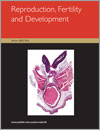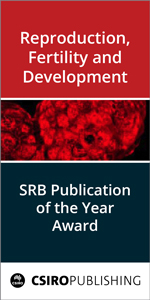Reproduction, Fertility and Development
Volume 28
Number 7 2016
Rapidly growing populations of feral horses can cause significant damage to landscapes and rural economies. Animal welfare concerns along with social and ethical considerations are increasingly precluding the use of lethal control methods to maintain acceptable population sizes, while non-lethal fertility control is not yet able to provide effective alternatives. This review explores the unique aspects of equine reproductive physiology that may provide opportunity for developing novel fertility vaccine strategies.
The number of eggs laid down in the ovary at birth and subsequently maintained during reproductive life influences the length of the female fertile lifespan. Recent studies have revealed a critical role for cell death regulators belonging to the BCL-2 protein family in determining how many eggs are available to females to support fertility. This review summarises our current understanding of the proteins responsible for initiating and mediating cell death during the establishment and maintenance of the female germline.
Testis cryopreservation is an efficient tool for preservation of the genetic potential of immature males that die before attaining sexual maturity. This is especially useful for buffalo calves that suffer a high mortality rate. Our results show that an optimum concentration of dimethylsulfoxide and fetal bovine serum could effectively preserve immature buffalo testicular tissues subjected to an uncontrolled slow-freezing protocol. Our findings encourage the cryo-banking of immature buffalo testicular tissues.
The ability to correctly select viable embryos is relevant to improving pregnancy rates and avoiding futile transfer attempts. Herein, we assess whether the cryotolerance of in vitro-produced embryos could be influenced by the length of in vitro culture and size of blastocoel cavity prior to vitrification. Faster embryo development underlies higher blastocyst cryotolerance. The best results for survival after warming were obtained with the vitrification of porcine blastocysts presenting a high degree of expansion, particularly when vitrification was performed after 6 days of in vitro embryo culture .
The upstream mechanisms involved in the processes of human labour are yet to be fully elucidated. This study shows that members of the nuclear receptor subfamily 4A (NR4A) are increased in fetal membranes and myometrium obtained from women after spontaneous term labour onset, and in the presence of various bacterial products. These findings suggest that NR4A family members may play a role in the processes of human labour including fetal membrane rupture and myometrial contractions.
Expression of nuclear progesterone receptor isoforms A and B (PGRA and PGRB, respectively) can be regulated by various factors. PGRA and PGRB mRNA and protein expression was determined in bovine endometrium after stimulation with selected luteotropic and luteolytic factors. The data suggest that these factors affect PGRA and PGRB mRNA and protein levels and, in this way, regulate the effects of progesterone on endometrial cells.
An immune challenge can affect the reproductive process in females. In this study, performed in ewes, we demonstrated that inhibition of cyclo-oxygenase 2 by meloxicam could minimise the negative effect of systemic inflammation induced by seven injections of bacterial endotoxin on gonadotropin-releasing hormone and LH secretion. However, the effectiveness of meloxicam treatment may be reduced during an inflammatory state characterized by high levels of prolactin.
This study analysed the effects of melatonin through its receptors (MT1 and MT2) on ram sperm functionality. Using immunofluorescence assays and by evaluating the effects of MT1 and MT2 receptor agonists and antagonists, we determined that the modulating effect of melatonin on ram sperm capacitation seems to be receptor mediated, primarily via MT2 receptors. These results may explain the effects of exogenous melatonin on ram fertility.
Hyaluronic acid is a major component of the extracellular matrix and is also found in body fluids. We show immunohistochemical localization of its synthases, main receptor and degrading enzymes in the camel oviduct. Regional differences in its synthesis and degradation suggest a differential role in the oviduct–gamete interaction in the ampulla and isthmus.
Environmental stresses can have detrimental effects on the developing embryo that resonate throughout the rest of the life of that individual. In this study we tested whether the negative effects are induced by changes the chromatin structure and, if so, whether this loosens the brake on the activity of retrotransposons. Although global chromatin changes were observed, the results indicate that retrotransposons are also held in check by other factors.
Filamin A is an actin-binding protein that was found to be associated with actin cytoskeletal remodelling of both luminal uterine epithelial cells (UECs) and endometrial stromal cells (ESCs) during early pregnancy. The distribution of filamin A in the endometrium was influenced by deciduogenic factors, while distribution of filamin A was found to be dependent on ovarian hormones. The expression of filamin A in the endometrium during early pregnancy contributes to the molecular and morphological changes that both UECS and ESCs undergo in order for them to be receptive to implantation by contributing to the remodelling of the actin cytoskeleton and hence the maintenance of plasma membrane stability of UECs and ESCs during early pregnancy.
Superovulation of mice is preferentially applied before sexual maturity of females is reached in order to maximize ova production. The effect of donor age in mice was evaluated with regard to distress induced by hormonal treatment and mating. Our results confirmed higher ovulation rates for immature females compared to adults and revealed no significant welfare issues for juvenile mice used for superovulation.
Increasing use of dietary supplementation with bioflavonoids such as quercetin raises concerns about their potential impacts on reproductive health. Here we show a negative impact of quercetin consumption on female fertility in the animal model and identify its target, transglutaminase 2, as a novel regulator of ovarian ageing. Thus the beneficial effects of quercetin may be overshadowed in females of reproductive age.
Inflammatory processes in the bovine endometrium caused by bacterial infection often result in reduced fertility. We aimed to elucidate the first inflammatory response of the bovine endometrium. Increased mRNA expression of pro-inflammatory factors was connected to inflammation in vivo and was provoked in endometrial epithelial cells co-cultured with the potentially pathogenic Bacillus pumilus. These findings suggest that the endometrium can react promptly to bacterial infections.
Amphibians are experiencing a global extinction crisis and captive assurance colonies in zoos and aquariums are unsustainable over the long-term due to poor reproduction. In this study, we aimed to improve our understanding of the use of hormone therapy in male toads for sperm collection. Our results have clear implications that frequent hormone-induced spermiation could have a negative effect on sperm production and we recommend that hormone injections be spaced a minimum of 2 weeks apart to optimise the health of the animals and provide optimum sperm quality for assisted reproductive technologies.
Oestradiol-based fixed-time artificial insemination (FTAI) programs have a relatively wide window of time for ovulation that may decrease pregnancy per AI (P AI–1) depending on semen processing. We have shown a 20% increase in P AI–1 in beef cattle when cooled versus frozen–thawed semen was used, because of better sperm quality and longevity.
Phosphoprotein phosphatase 1 (PPP1) is essential for male fertility and the key to understanding PPP1 function lies in the identification of its interacting partners. This study was undertaken to characterise several ankyrin repeat protein variant 2 (SARP2), a PPP1-interacting protein, highly enriched in testis and spermatozoa. Given the expression pattern of SARP2 and its association with PPP1 and sperm-associated antigen 9, we suggest that it plays a role in spermiogenesis and sperm function, namely in sperm motility and the acrosome reaction.
In seahorses, embryo development occurs within the male instead of the female, leading us to ask whether the male’s brood pouch has a similar function to the mammalian placenta. We specifically investigated whether the male’s diet before conception can influence the future survival and well being of newborn seahorses. Our experiment confirmed that to optimise the health and future survival of seahorses, male parents need to be supplied with dietary unsaturated fatty acids before they become pregnant.
The search for new diagnostic markers of male infertility takes into account factors other than sperm characteristics. The expression of matrix metalloproteinase (MMP)-9 and MMP-2 may be regulated by oxidative stress in various pathophysiological processes. Thus, the presence of seminal MMPs, their tissue inhibitors (tissue-specific inhibitor of metalloproteinase (TIMP)-1, TIMP-2) and their correlation with levels of oxidative stress parameters (i.e. advanced oxidation protein products (AOPP)) is interesting in the context of male fertility. High AOPP and an increased MMP-9 : TIMP-1 ratio alters the oxidative–antioxidative balance of the ejaculate, thereby reducing male fertility. Thus, reducing male fertility, and therefore these parameters may serve as additional diagnostic markers of semen quality and male reproductive potential.
Prenatal exposure to dexamethasone causes developmental alterations in the ovaries of offspring. This study demonstrates that dexamethasone administered during the fetal period enhances follicular atresia by activating programmed cell death, which, in turn, depletes the stock of ovarian follicles and can lead to reduction of fertility in adult females. The findings highlight the need for careful use of dexamethasone in pregnant women.




